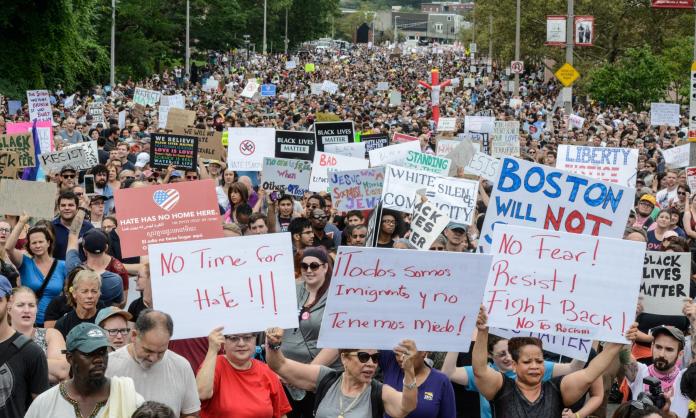It took a stunning confluence of events to convince the US Republican Party leadership to denounce fascism and white supremacy.
A march through the night at the University of Virginia, where white, tika torch wielding men, invoking the history of KKK lynch mobs, chanted “Blood and soil!” and “Jews will not replace us!” Nazi flags in the streets, and fascists armed to the teeth with a dizzying array of weapons. And, most terribly, the terrorist attack in which a 20-year-old white supremacist, James Fields, rammed his car into a crowd of anti-fascist demonstrators, injuring more than a dozen and killing 32-year-old Heather Heyer.
When, after all these things, the president of the United States said there was fault “on many sides”, and later insisted that some of these Nazis and white supremacists were “very fine people”, something snapped. One after another, leaders of the GOP discovered, for a moment at least, anti-fascism.
“No, not the same”, tweeted former presidential candidate Mitt Romney, in response to Trump’s remarks. “One side is racist, bigoted, Nazi. The other opposes racism and bigotry. Morally different universes.” One after another, they lined up to denounce the idea that fascism and anti-fascism could be equated. South Carolina senator Lindsay Graham said:
“Through his statements yesterday, president Trump took a step backward by again suggesting there is moral equivalency between the white supremacist neo-Nazis and KKK members who attended the Charlottesville rally and people like Ms. Heyer. I, along with many others, do not endorse this moral equivalency.”
Arizona senator John McCain tweeted: “There’s no moral equivalency between racists & Americans standing up to defy hate & bigotry”.
Of course, these statements from the doyens of the Republican Party are hypocrisy of the highest order. The GOP is the party of race hate. For a generation, the GOP’s electoral strategy has centred on playing to racial fears among white Americans. Donald Trump just says out loud what they have been dog-whistling for decades.
But that reality does nothing to undermine the fundamental truth of the assertion that fascists and anti-fascists are not the same. What is most striking about the post-Charlottesville statements by GOP politicians is that they are as much a rebuke to liberal politicians and the media, in Australia as well as the US, as they are to Donald Trump.
Since the far right re-emerged in Australia several years ago, there has been a relentless campaign arguing that left wing anti-fascists are as bad as the fascists they oppose.
The worst offenders are, of course, the Herald Sun, the Daily Telegraph and their ilk, which are barely better than the lunar right’s own publications. Consider the Herald Sun front page headlined “Unmasked” on 31 May last year, the day after the United Patriots Front and the True Blue Crew tried to march down Sydney Road in Coburg, the heart of multicultural Melbourne, to smash up an anti-racist rally. The paper’s editors described the fascists and neo-Nazis as “the anti-Islamists” and their anti-racist opponents as “extreme left anarchists”.
The Herald Sun is, of course, what it is. The bigger problem is that most of the liberal media have been little better.
After the clashes in Coburg, the Age editorialised: “What happened on Saturday was a clash between two gormless groups from the ideological fringes of our society”. According to them, protesters on both sides were “cowardly fools”.
The Age editorial was backed by a series of articles in the paper, all of which were in furious agreement with that central point. Cameron Houston talked about “morons from the radical fringes of the left and the right”. His suggestion about what to do? “More needs to be done to surveil and infiltrate these groups. The ringleaders need to be identified and dealt with, and their gormless followers will soon fall away.”
Darren Grey described what he called the “appalling brawling in Coburg, as left and right-wing protesters clashed on Bell Street”. This showed, Grey argued, “that Melbourne has a violence and aggression problem that transcends the political spectrum”.
Bianca Hall denounced anti-racist protesters as “young, masked men (who were indistinguishable from the UPF supporters except they weren’t adorned with Australian flags) intent on trouble”.
Victoria Police, too, blamed both sides equally. “There was riotous behaviour and it was appalling … the community shouldn’t have to put up with it”, commander Sharon Cowden said at a media conference. “You get the extreme ends and people coming along and all they’re looking for is a fight.”
All of the above statements are essentially indistinguishable from what Donald Trump said in his first press conference after Charlottesville: both sides are terrible.
The liberal media do come at it from a point of view different to that of right wing publications such as the Herald Sun and the Daily Telegraph, whose underlying position is support for far right racists. But, proclaiming themselves to sit in an amorphous “sensible centre”, the liberal media are unable to make, and are in fact deeply hostile to, the basic point that even Mitt Romney now makes: fascism and anti-fascism are in different moral universes.
The shock factor of Charlottesville helped transform the political debate. But what does it tell us about the state of liberal journalism that it requires armed demonstrators carrying Nazi flags, singing anthems of racial genocide and driving cars into crowds, to make people realise that fascism is a particular evil? That the people who follow its principles are worse than the people who feel compelled to take to the streets to oppose them?
One possible argument in defence of the “fault on both sides” case is that Reclaim Australia and its subsequent iterations might hold extreme anti-Islamic views, but are not on a par with US Nazism and white supremacy.
It is true that the far right in the US is considerably larger and more dangerous than its Australian counterparts. But pretending there aren’t fascists and Nazis at the heart of anti-Islam street politics in Australia is simply a denial of reality.
At the very first Reclaim Australia rally in Melbourne, many of the speakers had clear fascist links. A number of open neo-Nazis wearing swastika tattoos were part of the crowd that clashed with anti-racists.
The Nazi website Stormfront had no problem understanding what Reclaim Australia was about, declaring: “Over the weekend, proud White Australian protesters gathered in 16 cities and towns throughout their country to oppose minority groups who want to ‘change the cultural identity of the country’”. Reclaim Australia, Stormfront said, “reflects the angst of White Australians who are fed up and are willing to take a stand”.
Things soon became even clearer. In the months after this first rally, the right split and the more openly fascist United Patriots Front (UPF) emerged as the leading force on the far right. Between May and July 2015, anti-fascist and anarchist blogger Andy Fleming published a series of posts containing all the information required to understand the violent, neo-Nazi politics of UPF leader Blair Cottrell.
The now best-known indicator of Cottrell’s Nazi (as opposed to merely fascist) politics is his claim that there should be a picture of Adolf Hitler “in every classroom and every school, and his book [Mein Kampf] should be issued to every student annually”.
This could, on an extremely generous reading, be written off as a throwaway line. But the Hitler comment was only the tip of the iceberg. Take this anti-Semitic tirade by Cottrell, one of several diatribes exposed on Fleming’s slackbastard blog:
“For thousands of years these Jews have been expelled and chased out of European Nations for the same shit. Napoleon and Hitler were the last to stand against them (please don’t reply to this comment with ‘muh holocaust’ bullshit, cause that is a load of crap too). I[’]m fed up with all the tiptoe words like [I]lluminati and [Z]ionist … I’ve found that all these so-called ‘truth-seekers’ delve into free information until they hit the plateau of the real truth; that point at which they must admit that there is no [I]lluminati or [Z]ionist conspiracy, only a Jewish conspiracy.”
This foul anti-Semitism isn’t oblique reaction; it’s Hitler worship and full throttle Nazism.
Months later, some outlets, such as the Sydney Morning Herald, did publish articles pointing out that Cottrell was a neo-Nazi. But the “fault on both sides” rhetoric in the liberal press and even among some leftists continued and intensified.
This must stop. There are legitimate debates to be had among anti-fascists about a range of tactical and strategic issues. Red Flag has, for example, criticised the practice of some anarchists who wear face masks at demonstrations to protect themselves from the violence of right wing thugs and police. While understandable, wearing masks to anti-fascist protests helps the apologists for racist violence on the Herald Sun editorial board, and those in the liberal media who would hate nothing more than an actual insurgent mass movement against the far right.
But such criticisms are worth being considered only if they come from a starting point of recognising that people who wear masks on demonstrations, or who engage in other tactics that some on the left might disagree with, do not by adopting such tactics become as bad as the fascists.
Quite the contrary. So far, the forces that have taken to the streets against fascism have been marginal. The real question isn’t what is right or wrong with our tactics, it is where the hell is everybody else? A wrong tactic employed in the struggle to stop the growth of a fascist movement beats non-involvement in that struggle every day of the week.
Over the past two years, a coalition of anarchists and socialists has been on the front line of the fight against a revived Australian fascist movement. That struggle has been very important. Without it, it is unlikely the initial momentum of Reclaim Australia would have been beaten back, and the far right on the streets reduced to its fascist core.
But now, with the consolidation of Pauline Hanson and her party in parliament, the rise of the far right in the US, egged on by the most blatantly fascist-sympathising president in recent US history, and the broader rise of the far right around the world, it is time the broader left started taking anti-fascist organising seriously.
We need more than hundreds on the streets if we are going to push back the fascists. We need thousands.
In the wake of Charlottesville, the US left – both its liberal and socialist components – had to answer a simple question. Would fascist violence and murder intimidate them, or spur them to mobilise?
Tens of thousands of people answered that question in Boston the following week, when a far right rally was met with such an overwhelming response that they abandoned their plans and scurried away. Even Donald Trump had to pretend for a second that he endorsed the anti-fascist mobilisation.
The Boston demonstration made a simple point. If you want to avoid fascist and anti-fascist counter-rallies descending into small numbers street fighting and skirmishing, you need to mobilise masses of people against the fascists. When that happens, anti-fascism is joyous and peaceful. No one gets hurt. Everyone goes home.
That’s the kind of anti-fascist unity we need on the streets of Australian cities. The question is, can we get it now, or will we, because of those who don’t think the threat is serious enough yet, have to wait for our own Charlottesville before we mount the kind of mobilisation against fascism that is strong enough to crush it?









